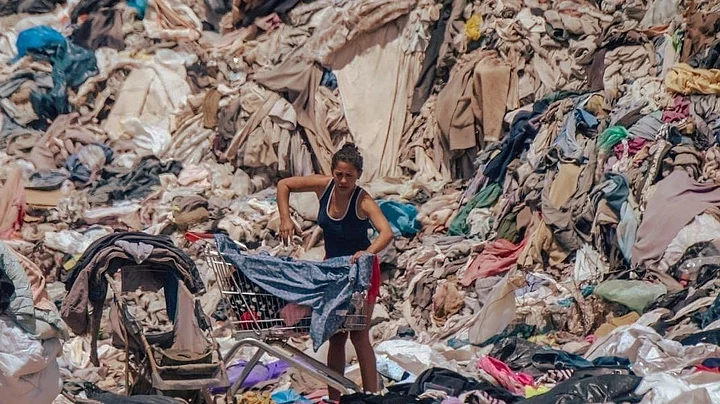At COP 26, where net-zero commitments were being announced, ‘phase-down’ versus ‘phase-out’ of coal was being debated, and even methane pledges were being made, it was the oil and gas lobby representatives who were walking around smug and grinning as they had dodged the bullet once again, thanks to the United States, the European Union and rich countries protecting their interests.
But outside the venue, a group of intrepid campaigners were pointing to the insidious role of oil and gas industry in the rising greenhouse gas (GHG) emissions from a completely unlikely source that the well-heeled suits at the conference were oblivious to, or deliberately ignoring – the role of the fashion industry in carbon emissions, specifically cheap synthetic fibres like polyester, nylon, acrylic and elastane, produced from oil and gas.
Synthetic fibres represent over two-thirds (69%) of all materials used in textiles, which is expected to reach nearly three-quarters by 2030. The production of polyester alone is leading to annual GHG emissions equivalent to 180 coal power plants, and this is projected to nearly double by 2030.
1.29 Billion Barrels of Oil a Year
As the transport and energy sector’s demand for oil and gas declines, the fashion industry’s dependence on fossil fuel-derived synthetics has become the backbone of the industry as well as the catastrophic fast-fashion business model. The production of synthetic fibres currently accounts for 1.35% of global oil consumption, which exceeds the annual oil consumption of Spain and amounts to 1.29 billion barrels of oil a year. By 2016, the apparel and footwear industries accounted for approximately 8 per cent of global greenhouse gas (GHG emissions).
It is not as if the industry itself is unaware of its carbon footprint. There is a United Nations-led initiative launched in December 2018, called the Fashion Industry Charter for Climate Change, which aims to drive apparel manufacturers to net-zero greenhouse gas emissions no later than 2050, in line with the goal of keeping global warming below 1.5C.
Since the launch of the charter, 125 companies have committed to climate action. In 2019, some of the largest fashion brands in the world also put their names on Science Based Targets initiative net-zero corporate standard.
Companies that have signed the charter include big brands like Adidas, Burberry, Decathalon, Fossil, Gap, Levi Strauss, Ralph Lauren and Mango. But their carbon targets and initiatives remain voluntary, and even as brands make impressive-sounding sustainability declarations, the companies behind the brands are reluctant and obtuse about what real steps the industry is taking to reduce its carbon footprint or rein in overproduction.
Overproduction & Excessive Consumption
According to Nusa Urbancic of the Changing Markets Foundation, which launched a new report titled “Synthetics Anonymous: Fashion brands‘ addiction to fossil fuels” on the sidelines of COP26, “From production to end of life, cheap synthetic fibres, the main drivers of the fast-fashion business model that is propelled by excessive consumption and overproduction, cause significant environmental issues.”
The Changing Markets report not only exposes fashion brands’ addiction to synthetics but also demonstrates rampant greenwashing across their voluntary commitments and products. The report found that the 46 clothing companies they analysed are still largely ignoring growing plastic pollution and waste crisis stemming from their addiction to synthetic fibres.
In addition to a significant lack of transparency about the amount and source of synthetics in their collections, fashion brands resort to greenwashing tactics – such as downcycling polyethene terephthalate (PET) bottles to clothes – rather than moving to truly circular solutions, in which products are designed to be more durable, reusable, repairable and recyclable.
Especially of concern is the lack of a systemic approach to addressing the environmental and health risks of microplastic pollution. Most brands only consider end-of-pipe solutions, such as washing machine filters and wastewater treatment plants, which merely shift the problem elsewhere.
There are many ways the fashion industry can reduce emissions, besides moving away from synthetic fibres, like switching factories from coal to renewable energy, among others. But according to Carry Somers, founder of Fashion Revolution, a fashion activism movement,
“The real and most powerful way to reduce the industry’s impact would be to make less stuff and for the consumers to revisit their wardrobes and see if they really need to buy more.”Carry Somers, founder, Fashion Revolution
The truth is if fashion was a nation, it would be the seventh-largest economy, with emissions higher than aviation and shipping combined. The fashion industry needs to address this urgently.
(Shailendra Yashwant is an independent journalist and photographer participating in COP 26 as observer for Climate Action Network South Asia CANSA. This is an opinion piece and the views expressed above are the author’s own. The Quint neither endorses nor is responsible for the same.)
